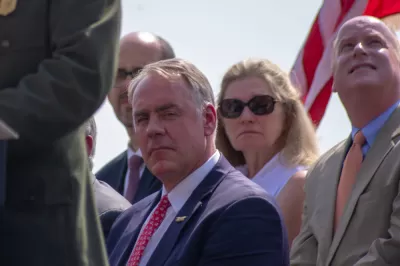With a tweet from the president on Saturday morning, the public learns that yet another embattled cabinet member will lose his job. Zinke, a former congressman from Montana, is the subject of numerous investigations and controversies.

“Secretary of the Interior @RyanZinke will be leaving the Administration at the end of the year after having served for a period of almost two years,” Mr. Trump wrote on Twitter, report Julie Turkewitz and Coral Davenport for The New York Times. Zinke was tapped in December 2016 to be the nominee for Interior secretary.
Interior Secretary Ryan Zinke's departure comes amid numerous ethics investigations into his business dealings, travel and policy decisions. ... Mr. Trump had tolerated the seemingly endless drips of scandal surrounding Mr. Zinke in part because he liked him personally.
Zinke submitted his resignation, according to Washington Post reporters Juliet EilperinJosh Dawsey, Darryl Fears.
[T]he White House had been pushing Zinke to resign for weeks, administration officials said. Last month, these officials said, Zinke was told he had until the end of the year to exit or be fired.
"Rather than working across the aisle and across the country to preserve our country’s natural legacy, Zinke will be remembered for his corrupt behavior and his constant attacks on the lands, waters and wildlife that we all hold dear," stated Sierra Club Executive Director Michael Brune.
Similarities to another controversial cabinet member
In an Oct. 30 Times article about an inquiry into a Montana land deal involving Mr. Zinke and the chairman of the energy giant Halliburton, Davenport noted the comparison made to Scott Pruitt, former administrator of the Environmental Protection Agency, who resigned in July.
“It’s similar to Pruitt,” said Patrick A. Parenteau, an expert in energy and environment law at Vermont Law School. “It suggests someone who doesn’t really have a deep respect for law and procedure, who likes to cut corners and go right up to the edge of the law.”
Elections have consequences
Another factor that played into Zinke's decision to submit his resignation was the result of the midterm elections which saw the Democrats gain control of the House of Representatives. Zinke has feuded with Representative Raúl M. Grijalva (D-Tucson, Ariz.), the incoming chairman of the House Natural Resources Committee.
A few months ago, the White House Counsel’s Office indicated to some West Wing aides that officials would be less likely to be subpoenaed by the new House majority if they left before the new Congress was sworn in in January.
"[A]fter 30 years of public service, I cannot justify spending thousands of dollars defending myself and my family against false allegations," tweeted Zinke.
Replacement?
Waiting in the wings is Deputy Secretary David Bernhardt, also a subject of considerable controversy. "Democrats called him a 'walking conflict of interest' for representing corporate interests opposed to regulations at the department that aim to help clean air and water," notes a July 2017 post on his confirmation by the Senate.
FULL STORY: Ryan Zinke, Face of Trump Environmental Rollbacks, Is Leaving Interior Department

Alabama: Trump Terminates Settlements for Black Communities Harmed By Raw Sewage
Trump deemed the landmark civil rights agreement “illegal DEI and environmental justice policy.”

Study: Maui’s Plan to Convert Vacation Rentals to Long-Term Housing Could Cause Nearly $1 Billion Economic Loss
The plan would reduce visitor accommodation by 25% resulting in 1,900 jobs lost.

Why Should We Subsidize Public Transportation?
Many public transit agencies face financial stress due to rising costs, declining fare revenue, and declining subsidies. Transit advocates must provide a strong business case for increasing public transit funding.

Paris Bike Boom Leads to Steep Drop in Air Pollution
The French city’s air quality has improved dramatically in the past 20 years, coinciding with a growth in cycling.

Why Housing Costs More to Build in California Than in Texas
Hard costs like labor and materials combined with ‘soft’ costs such as permitting make building in the San Francisco Bay Area almost three times as costly as in Texas cities.

San Diego County Sees a Rise in Urban Coyotes
San Diego County experiences a rise in urban coyotes, as sightings become prevalent throughout its urban neighbourhoods and surrounding areas.
Urban Design for Planners 1: Software Tools
This six-course series explores essential urban design concepts using open source software and equips planners with the tools they need to participate fully in the urban design process.
Planning for Universal Design
Learn the tools for implementing Universal Design in planning regulations.
Smith Gee Studio
Alamo Area Metropolitan Planning Organization
City of Santa Clarita
Institute for Housing and Urban Development Studies (IHS)
City of Grandview
Harvard GSD Executive Education
Toledo-Lucas County Plan Commissions
Salt Lake City
NYU Wagner Graduate School of Public Service




























